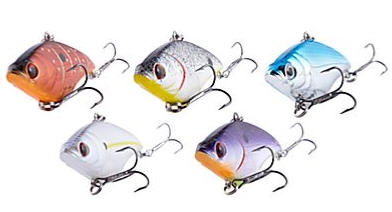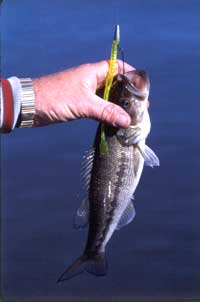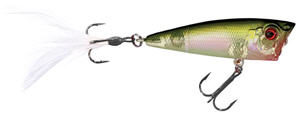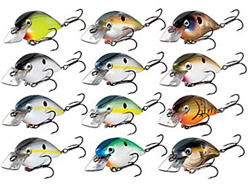
Many bass pros place far less emphasis on lure color than on other factors. They know it's more important to learn fish's location and mood (active or inactive) than to pick a bait with the right size, shape and action. Then, finally, comes choosing lure color. Its priority in this selection process is indicative of its importance, or lack of it.

top-performing colors
Still, since lures are sold in every shade and combination imaginable, fishermen need some criteria for deciding which lure colors to tie on. Experience shows that some colors are indeed more effective than others. Following are basic guidelines many fishing pros use in choosing lure color for the broad spectrum of locations and water conditions.
The Rule of Thumb to Picking Colored Baits
 The most fundamental rule is to fish brightly colored baits in dingy or muddy water and light, subtle colors in clear water. The logic here is that a bass' visibility is hampered by silt, and colors like chartreuse, yellow and orange are easier to see than bone, pumpkinseed and smoke. On the other hand, when water is clear and the fish can get an unobstructed look at the bait, it's best to go with softer, more natural colors.
The most fundamental rule is to fish brightly colored baits in dingy or muddy water and light, subtle colors in clear water. The logic here is that a bass' visibility is hampered by silt, and colors like chartreuse, yellow and orange are easier to see than bone, pumpkinseed and smoke. On the other hand, when water is clear and the fish can get an unobstructed look at the bait, it's best to go with softer, more natural colors.
For instance, when water clarity is poor (visibility a foot or less), many pros use spinnerbaits with chartreuse or yellow skirts or crankbaits in a "fire tiger" pattern — orange belly, chartreuse sides, dark green back. Conversely, in clear water, white or white/blue spinnerbaits are favorites, as are crankbaits in chrome, bone and various natural finishes (crawfish, shad, sunfish, etc.).

The same principle applies with soft plastic fishing baits — worms, lizards, grubs and tubes. In dingy water, dense colors are the rule, and two-color worms with bright tails offer added visibility. Examples are grape, black or blue baits with chartreuse, red or orange tails. But in clear water, lighter, more translucent lure colors seem to work best. Favored colors here include pumpkinseed, motor oil, strawberry and smoke. Also, bits of metalflake molded into these see-through worms provide extra flash and attraction to bass in high-vis situations.

The jig-and-pig is a standard bait for flipping, pitching or casting. In clear water, preferred color combinations are a black jig/blue trailer (either a pork chunk baits or plastic crawfish baits), black/brown and pumpkin pepper/green; in stained water, black/yellow and black/chartreuse are perennial producers
When to Make Lure Adjustments

work best.
Besides water clarity, time of year and preferred forage should also be considered in choosing lure color. For instance, crawfish are a main menu item on many Southern lakes in the pre-spawn, and unless the water is muddy, a crawfish-pattern crankbait like the customer top rated Rebel Crawfish bait or a brown/brown jig-and-pig emulate this natural prey. In the post-spawn, many bass feed on small bluegills, and sunfish-colored lures are effective. When bass are schooling in summer or chasing shad in bays in the fall, a chrome or shad-colored lure is a logical choice.
Two particular fishing situations call for special color considerations: night fishing and topwater fishing. Most expert night fishermen use black or dark blue lures. The theory is that these colors provide a more distinct profile when silhouetted against the lighter background of the water's surface. Thus, a dark lure is easier for bass to see and strike accurately at night.

Topwater Hard Baits
Most topwater lure specialists prefer dark-colored baits early and late in the day when visibility is poor, and light-colored baits during bright periods. They are quick to note, however, that a surface lure's action and noise are far more important in triggering strikes than its color.
Final Verdict

Crankbait Kit
There are no hard-and-fast rules in selecting lure colors, and confidence may be the most important factor in this process. Beginning bass anglers should follow the above guidelines and experiment with different colors and combinations to discover which ones work best on their home waters. Then they should stock their tackle boxes with just a few basic colors and forget about the dozens of others they don't have.
Tip: Purchase a fishing lure kit. Take advantage of what a lure kit has to offer like the Strike King KVD 13-Piece Square Bill Crankbait Kit. Typically, kits are affordably priced and offer a full selection of the most popular baits and lures.
Tip: This is what the pros do. They carry only a few shades in worms, crankbaits, spinnerbaits, etc. They know each color works in a particular water clarity/forage situation, and when they encounter it, they can tie on the matching lure with assurance. This way they avoid confusion, and they can worry more about catching bass than fumbling through the tackle box searching for the magic color.
Tip: How to Choose Lure Colors Through the Eyes of a Bass
- 426291 views

